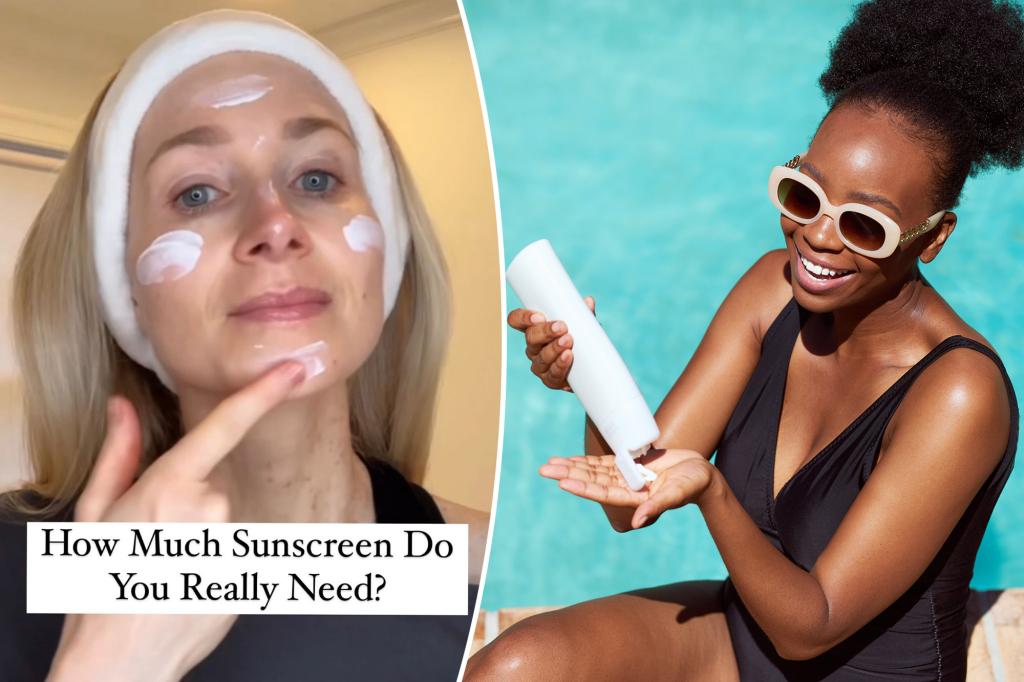Many adults are not wearing sunscreen, which can lead to sun damage. Dr. Whitney Bowe, a board-certified dermatologist, recommends using two finger lengths of sunscreen to cover your face, neck, and ears to protect from the sun’s harmful effects. She emphasizes the importance of thoroughly rubbing in mineral sunscreens to avoid a white cast. Dr. Caren Campbell, another board-certified dermatologist, suggests using an ounce of sunscreen, approximately the size of a shot glass, to cover areas like the ears, feet, head, scalp, and neck to prevent skin cancer. She highlights the importance of sunscreen application to areas often neglected like the temples, ears, and lips.
The two-finger sunscreen rule has been around for at least two decades, but some experts are urging for more personalized recommendations. The American Academy of Dermatology recommends using a sunscreen with an SPF of at least 30, which can block 97% of the sun’s UVB rays. Sunscreen should be reapplied every two hours, especially after sweating, being in the water, or towel-drying. Water-resistant sunscreen should be reapplied every 40 to 80 minutes to ensure continuous protection from the sun’s harmful rays. Neglecting sunscreen can lead to severe consequences, including sunburn, peeling, and an increased risk of skin cancer.
Many adults have admitted to not wearing sunscreen regularly, which can have detrimental effects on skin health. Experts suggest using a sufficient amount of sunscreen to cover exposed areas of the body and ensuring even application to avoid sun damage. By following the recommended guidelines for sunscreen usage, individuals can protect themselves from harmful UV rays and reduce the risk of skin cancer. It is crucial to be proactive in applying sunscreen regularly, especially in areas of the body that are often overlooked, such as the ears, neck, and lips.
Dr. Whitney Bowe recommends using two finger lengths of sunscreen on your face and neck while ensuring additional coverage for the ears and any other exposed areas. Mineral sunscreens, which contain zinc oxide or titanium dioxide, are effective in reflecting ultraviolet light from the sun. Dr. Caren Campbell advises using an ounce of sunscreen, equivalent to a shot glass, to protect areas like the scalp, head, and feet that are commonly exposed to the sun. It is essential to reapply sunscreen every two hours and after activities like swimming or sweating to maintain optimal sun protection.
The prevalence of adults not wearing sunscreen regularly highlights the importance of promoting sun safety practices to prevent skin damage and reduce the risk of skin cancer. The one-size-fits-all approach of the two-finger sunscreen rule may be outdated, and experts are advocating for more personalized recommendations to ensure adequate sun protection. By following the guidelines provided by dermatologists and organizations like the American Academy of Dermatology, individuals can make informed decisions about sunscreen application and take steps to protect their skin from the sun’s harmful rays.
In conclusion, the use of sunscreen is vital in protecting the skin from sun damage and reducing the risk of skin cancer. Experts recommend using a sufficient amount of sunscreen, reapplying it regularly, and covering all exposed areas of the body to ensure maximum protection. With the prevalence of adults not wearing sunscreen regularly, it is crucial to raise awareness about the importance of sun safety practices and encourage individuals to make sunscreen a part of their daily routine. By following the advice of dermatologists and health organizations, individuals can take proactive steps to safeguard their skin health and minimize the harmful effects of UV radiation.


